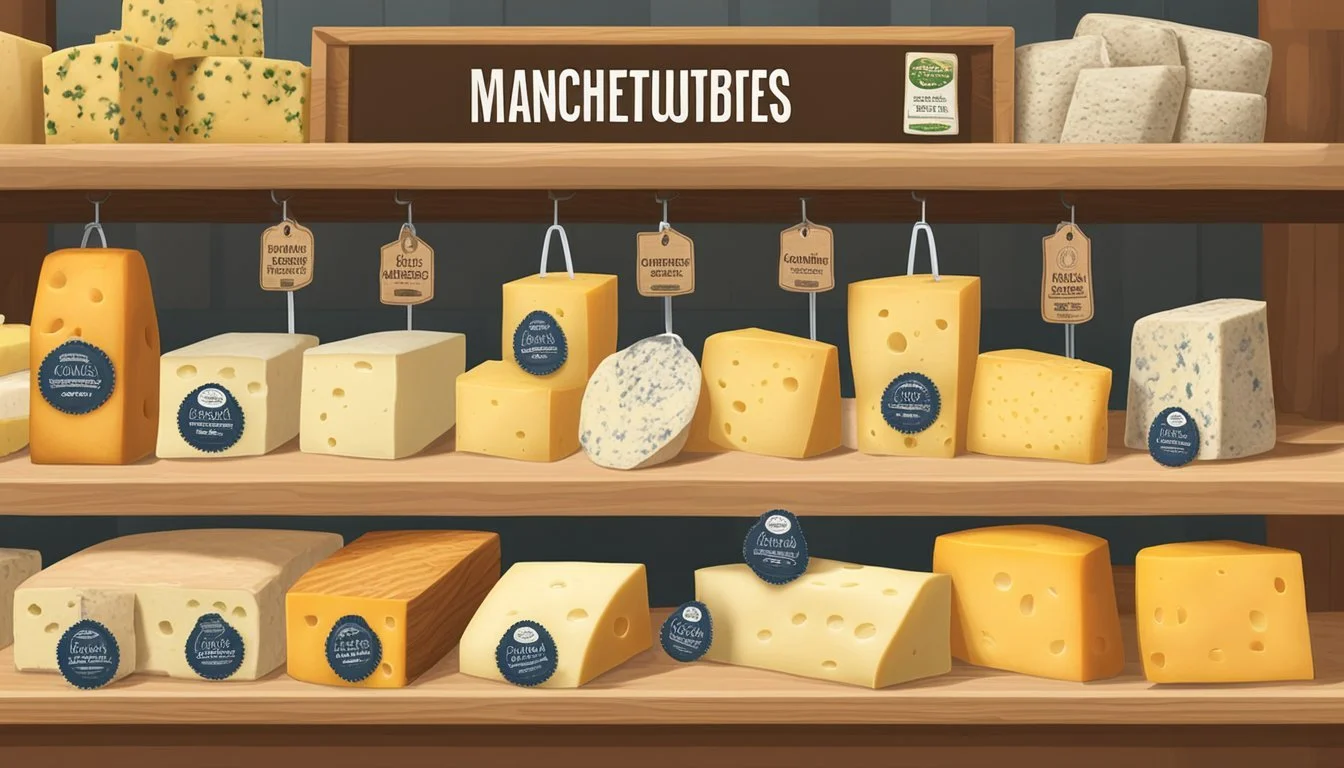Manchego Cheese Substitutes
Top Alternatives for Your Recipes
Manchego cheese, originating from the La Mancha region of Spain, is a beloved staple in Spanish cuisine known for its distinctive flavor profile and firm texture. As a sheep's milk cheese (What wine goes well with cheese?), it presents a rich, nutty taste that ranges from mild to intensely complex, depending on its age. Often referred to as 'queso manchego,' it has a unique quality deeply entrenched in Spanish heritage and is a common choice for cheese platters, sandwiches, and as a companion to wine.
For those who might not have access to Manchego or are seeking a cheese with a similar profile, numerous substitutes offer comparable flavors and textures. When searching for an alternative, it's important to consider how closely the substitute matches Manchego's mildly sweet and nutty characteristics, along with the cheese's firm yet crumbly consistency. Cheeses from both within and beyond Spain can serve as suitable replacements, ensuring that dishes requiring Manchego still retain their intended culinary appeal.
Understanding Manchego Cheese
Manchego cheese is a distinctive part of Spanish cuisine, with a rich heritage tied to the La Mancha region. It's known for its unique characteristics stemming from the milk of the Manchega sheep.
Origin and Production
Manchego cheese, or queso manchego, originates from Spain's La Mancha region. This cheese is made from the milk of the Manchega sheep, which graze on the plateaus of Central Spain. Manchego is produced in various stages of aging:
Semicurado: Aged for 3-6 months, it is creamy and mild.
Curado: Aged 6-12 months, with a firmer texture.
Viejo: Aged over a year, resulting in a crumbly texture.
Characteristics
Manchego cheese is lauded for its rich flavor profile, which includes:
Sweetness: A subtle sweetness that is characteristic of this cheese.
Nutty: A complexity added by the nutty undertones.
Texture: A crumbly texture becomes pronounced as the cheese ages.
The flavor of Manchego cheese can also be described as well-balanced, with a certain depth that makes it easily distinguishable from other cheeses.
Culinary Uses
In Spanish cuisine, Manchego cheese has versatile culinary uses. It can be served in tapas, paired with fruits, or included in recipes like pastas and salads. Its melting qualities make it suitable for:
Quesadillas: A staple in which Manchego can be a key ingredient.
Pasta dishes: Adds depth with its creamy and mild flavor when melted.
Salads: Offers a burst of flavor and texture when used as shavings.
The adaptability of Manchego cheese in dishes from snacks to main courses speaks to its revered status in both Spanish cuisine and global kitchens.
Primary Manchego Cheese Substitutes
Selecting a substitute for Manchego cheese involves finding options that share similar taste profiles and textures. Manchego is known for its mild, sweet, and nutty flavor, as well as a texture that can range from semi-soft to hard.
Spanish Alternatives
Zamorano: A sheep's milk cheese like Manchego, Zamorano mirrors the rich, nutty taste and offers a similar firmness, making it an ideal Spanish substitute.
Taste: Nutty, similar to Manchego
Texture: Firm
Iberico: Another Spanish cheese made from a blend of cow's, sheep's, and goat's milk, can serve as a substitute, providing a complex flavor.
Taste: Nutty with a hint of sharpness
Texture: Semi-firm to firm
Italian Options
Pecorino Romano: A well-aged Italian cheese that imparts a sharp and tangy flavor, adding a bold taste to dishes that require the maturity of an aged Manchego.
Flavor: Bold, tangy
Texture: Hard
Asiago: This cheese comes in fresh and aged varieties, offering a range of flavors from mild to sharp, which can mimic Manchego's versatile use in cooking.
Flavor: Mild to sharp
Texture: Semi-soft to hard
Parmigiano Reggiano: Known as Parmesan, this hard, granular cheese provides a savory depth with nutty overtones.
Flavor: Nutty, savory
Texture: Hard, crumbly
Other European Varieties
English Cheddar: While the texture differs, a mild to medium cheddar can be a substitute for young Manchego, offering a familiar taste profile.
Flavor: Mild, nutty
Texture: Semi-soft to hard
Comté: This French cheese has a complex, nutty flavor that works similarly to Manchego in cooking.
Flavor: Complex, nutty
Texture: Firm, pliable
Gruyère: Another French cheese, Gruyère, has a slightly sweet and nutty flavor that pairs well in recipes calling for Manchego.
Flavor: Sweet, nutty
Texture: Dense, slightly grainy
Versatile Cheese Alternatives
When looking for a Manchego cheese substitute, one should consider the cheese's melting qualities and flavor profile. Substitute choices range from mild and melty to sharp and piquant, catering to various culinary applications.
Mild and Melty
For textures and flavors that best mimic Manchego cheese, Monterey Jack stands out. It’s a semi-firm cheese, recognized for its excellent melting qualities and mild taste. This American cheese is perfect in recipes that call for a smooth, melt-in-your-mouth experience.
Mozzarella Cheese: Known for its supreme meltability, mozzarella is a go-to substitute for a soft, gooey texture.
Muenster Cheese: This American cheese offers a similar rich and creamy melt as Manchego.
Nutty and Firm
Some cheeses mirror the nutty essence and firm texture of Manchego, making them suitable for grating over dishes or slicing.
Asiago Cheese: With a flavor that grows sharper with age, asiago provides a nutty profile.
English Cheddar Cheese: A sharp, somewhat nutty cheese which can replace Manchego, especially when aged.
Table of Nutty and Firm Alternatives
Cheese Origin Texture Nutty Flavor Melting Capability Asiago Italy Firm Moderate Good English Cheddar England Firm to Crumbly Strong Varies by Age
Sharp and Piquant
For those who prefer a more pronounced flavor that can add zest to any dish, the following alternatives can be considered.
Pecorino: This hard Italian cheese brings a sharp and salty profile, increasing the flavor ante.
Parmigiano Reggiano: Another Italian favorite, known for its granular texture and sharp, complex taste.
Chihuahua Cheese: Often likened to a sharper Monterey Jack, this cheese also offers excellent melting qualities.
Important Notes:
Gruyère, while not explicitly mentioned in the search results, is another well-regarded substitute due to its smooth melting behavior and slightly sweet, nutty flavor, but with a more complex sharpness that intensifies with age.
Non-Dairy and Vegan Substitutes
When seeking an alternative to Manchego cheese, individuals pursuing a vegan lifestyle or those with dairy restrictions have various options. These substitutes offer similar qualities to Manchego without the use of animal products.
Plant-Based Varieties
Vegan options for substituting Manchego cheese include cashew cheese and tofu. Cashew cheese is praised for its creamy texture and is commonly enriched with nutritional yeast to achieve a cheese-like flavor. It is a preferred choice for those who enjoy a rich and smooth consistency analogous to Manchego.
Tofu, on the other hand, stands out due to its versatility. To replicate the texture of Manchego cheese, tofu can be crumbled and adequately seasoned. It absorbs flavors well, which allows it to mimic the savory and slightly sweet undertones of Manchego when left to marinate with salt and complementary seasonings for at least three hours.
Purchasing Vegan Cheese
Finding vegan Manchego cheese substitutes has become more accessible. Consumers can locate these products in many health food stores, specialty shops, and larger grocery store chains. When searching for vegan cheese alternatives, affordability might vary, but a broad range of options ensures that there are selections to fit different budgets. Here are some considerations when purchasing vegan cheese:
Availability: While specialty stores are more likely to carry a diverse selection, many mainstream supermarkets now stock vegan cheeses.
Affordability: Prices can fluctuate, but some brands offer cheese alternatives that are budget-friendly without compromising on flavor or texture.
Labeling: Shoppers should look for labels certifying the product as vegan to ensure that it does not contain any hidden dairy or animal-based ingredients.
By exploring the variety of plant-based cheeses available, consumers can find suitable and enjoyable substitutes for Manchego cheese that cater to their dietary preferences or needs.
Using Substitutes in Cooking
When incorporating substitutes for Manchego cheese in cooking, it's important to consider how they will affect the texture, flavor, and overall outcome of the dish.
Matching Textures and Flavors
Substitutes should mimic the buttery and crumbly texture of Manchego cheese to ensure consistency in recipes. Cheeses like sharp Cheddar or Monterey Jack can offer a similar texture and a complimentary nutty flavor. For dishes where the intense and salty flavor of Manchego is central, such as in gratins or on cheese platters, aged alternatives like Pecorino Romano can be used, as their flavors stand out more after cooking or grating.
Texture Match:
Sharp Cheddar - crumbly and can offer a nutty hint.
Monterey Jack - offers a creamy texture akin to Manchego.
Flavor Match:
Pecorino Romano - provides an intense and salty flavor suitable for strong-flavored dishes.
Preparation and Pairings
When preparing dishes that typically feature Manchego, consider how your substitute will melt and pair with other ingredients. For cooked dishes like quesadillas or sandwiches, a cheese that melts smoothly, such as Mozzarella, is a practical option. With pasta dishes, consider a cheese with a creamy texture that can complement cured meats and intensify when heated.
Melting: Mozzarella - ideal for dishes requiring a good melt.
Pairings:
Pasta - cheeses with creamy textures can enhance the dish.
Cured Meats - aged cheeses with strong flavors are good pairings.
Cooking with Vegan Alternatives
Vegan alternatives must replicate Manchego's unique qualities without animal products. Firm tofu, seasoned appropriately and marinated in salt and other seasonings, can take on a somewhat similar role. Nutritional yeast and almond cheese are also viable for their nutty flavor profiles, which pair well with pizza or pasta, and offer a pleasing texture when crumbled over vegan dishes.
Vegan Texture:
Firm Tofu - marinate to mimic crumbly texture.
Almond Cheese - can crumble like Manchego for texture.
Vegan Flavor:
Nutritional Yeast - adds a nutty flavor to vegan cheeses.
Almond Cheese - provides a milder nutty profile suitable for vegan versions of pasta or pizza.
Health and Nutritional Considerations
When considering substitutes for Manchego cheese, it is important to compare the nutrient content of potential alternatives and be aware of lactose and dairy allergies that could influence dietary choices.
Comparing Cheese Nutrients
The nutritional profile of cheese can vary widely between types. Manchego cheese is known for its high calcium and protein content. Substitutes such as Pecorino Romano and Gruyère also deliver similar amounts of these crucial nutrients. However, cheeses like Havarti can be creamier and may provide different fat and cholesterol levels. For those concerned about cholesterol, checking the labels of substitutes is vital as nutrient contents can differ. Below is a table illustrating the differences per 100g for Manchego and two common substitutes:
Nutrient Manchego (100g) Pecorino Romano (100g) Gruyère (100g) Calories Manchego Pecorino Romano Gruyère Protein 26g 25.8g 29.8g Calcium 670mg 760mg 1011mg Cholesterol 90mg 105mg 110mg
Lactose and Dairy Allergy Concerns
Persons with lactose intolerance or dairy allergies should scrutinize cheese substitutes carefully. Many aged cheeses, including Manchego, are naturally lower in lactose due to the fermentation process. In contrast, a substitute like Ricotta Salata retains more lactose. Dairy allergies present a different challenge, as all traditional cheese substitutes share a basis in dairy and might contain the protein casein, often the allergen in question. For those avoiding dairy altogether, vegan cheese substitutes can provide a Manchego-like nutty flavor without the use of animal rennet or dairy, utilizing plant-based proteins and oils instead. It's essential to read ingredient lists to ensure the substitute fits within the bounds of dietary needs and restrictions.
Where to Buy and Preservation
When seeking Manchego cheese substitutes, consumers should know where to find alternatives and how to maintain their quality through proper storage.
Finding Substitutes in Stores
Shoppers looking for Manchego cheese substitutes can usually find suitable alternatives in well-stocked cheese sections of grocery stores. For an affordable option that mimics the creamy texture and nuanced flavor of aged Manchego, one might consider Havarti or Gruyere. Specialty food shops and cheese mongers often carry a broader range of alternatives including aged gouda which shares a similar firmness.
Storing Cheese Properly
To preserve the quality of cheese, proper storage is essential. Wrapping the cheese in parchment paper followed by a loose layer of aluminum foil helps maintain the desired moisture level and prevents the cheese from absorbing other flavors from the refrigerator. For aged cheese with a harder texture, storing them in the least cold part of the refrigerator, such as a vegetable crisper, can prevent them from drying out. Cheese with a creamy texture, such as substitutes for Manchego, benefit from being stored at higher humidity levels to retain their characteristic mouthfeel.
Conclusion
Manchego cheese, with its distinctive taste and texture, is a renowned Spanish cheese that plays a significant role in various dishes. Its flavor profile, marked by sweet and nutty undertones, and its firm yet creamy texture can be a unique addition to recipes. However, one might need to find suitable substitutes for Manchego cheese that align closely with these characteristics.
The substitutes listed offer a range of flavors and textures that can mimic the essence of Manchego to a certain extent, each bringing its own qualities to the table. Here's a brief overview:
Monterey Jack: Creamy and mildly flavored, ideal for melting.
Asiago: Offers a nutty flavor, best used when aged.
Cheddar: Widely available, it provides a sharper taste.
Zamorano: Another Spanish cheese, similar to Manchego, but with a more robust flavor.
Parmesan and Pecorino Romano: Hard Italian cheeses with a robust profile, suitable for grating over dishes.
Individual preferences for texture and saltiness vary, and so does the specific role of the cheese in the dish. For instance, some recipes may require a cheese that melts well, while others need a firmer cheese to be served as part of a cheese platter.
When opting for a substitute, one might consider the purpose the Manchego serves in the dish. It's advisable to taste-test and adjust the quantity of the substitute used based on its intensity as not all cheeses share the exact salt content or flavor strength. Whether for cooking, garnishing, or as part of a cheeseboard, these alternatives offer a viable resolution for the absence of Manchego cheese.










